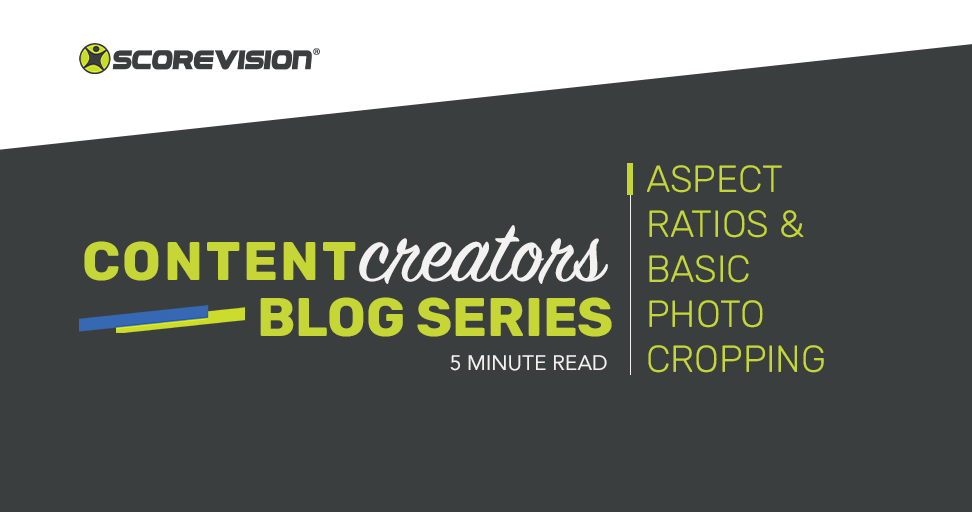Using the correct media size is vital for graphics planned to be shown on the LED displays. It’s important to know the model of your display so that you can determine the specifications of the Brand Wrapper you need to create. Be sure you or your students are aware of how the media content will be used on the board to be able to know the aspect ratio for the desired media.
Check out this video for a brief overview of Aspect Ratios.
Aspect Ratio
Aspect Ratio refers to the proportional relationship between the width and height of an image or video frame, typically represented by two numbers separated by a colon. The first number signifies the width, while the second number signifies the height. Common examples of mainstream display aspect ratios include 16:9 for high definition digital video (e.g., TV, YouTube) and 9:16 for vertical HD layouts (e.g., social media, online). On the other hand, specialty aspect ratios like 17:9 for 2k and 4k DCI and 4:5 for photography are also prevalent.

When it comes to LED displays, there is no standard aspect ratio as each LED varies. ScoreVision’s scoreboard software has layout options to match any aspect ratio to coincide with the vast possibility of LED display sizes and aspect ratios. This allows for ScoreVision to be used with nearly any LED display, existing or new installation upgrades.
When media content does not match the aspect ratio of the display area, the display typically will only match one proportion of the display size. For example, if a LED board is 4:3, and is showing a full screen video at 16:9, the video will be played on the board with black bars on the top and bottom of the display.
ScoreVision has a solution to help prevent those unappealing black bars on LED displays. We offer layouts that are not only made up of the aspect ratio for the overall display size, but utilize additional media nodes and advertising sequences throughout the display. While the aspect ratios of LED displays can be different, each node or sequence type within a layout typically uses standard media aspect ratios. For example, ScoreVisions video scoreboard layout uses a 16:9 media node within the overall layouts to play hype videos, Live video feeds, and video advertising. ScoreVision uses Brand Wrappers fitting the aspect ratio of the full display to fill in the area of the display layout that is not used by the nodes within the display.
Aspect ratio media configuration is just one aspect that plays into the visual output quality of a display. Pixels, the tiny areas of illumination on a display that compose an image or video, play a crucial role in determining the quality of the visual output. The pixel aspect ratio (PAR), representing the width of a pixel to its height, is essential for video production rendering output. The resolution, which indicates the pixel count in digital imaging, is crucial for TVs/monitors (measured in pixels per inch) and LEDs (measured in pixel pitch). Key examples of resolution include 2160 x 3840 and 1920 x 1080 for 16:9 high definition video and 1080 x 1080 for a square image resolution like Instagram. Media resolution for content being displayed on LED can impact the quality of the imagery based on the specifications of the display. To learn more about the makeup of LED displays, check out our other blog post – LED Basics: How To Choose The Best LED For Video Scoreboards
Understanding aspect ratios of LED displays is vital for optimizing visual content. Comparing LED pixels to digital image pixels, considering pixel pitch, and utilizing LED processors to select the input region for display are essential technical aspects. Furthermore, aligning LED and digital image pixels, scaling images to fit the display correctly, and addressing distortion or loss of quality during scaling are critical considerations.
Basic Photo Cropping
When cropping a photo, it's important to consider the aspect ratio of the final image. If you want to maintain the original aspect ratio, you should crop the image without changing the proportions of the width and height. This can be done by selecting a crop tool that locks the aspect ratio or manually adjusting the crop to match the desired ratio.
If you don't mind changing the aspect ratio, you can crop the image to any size or shape you like. Keep in mind that changing the aspect ratio can affect the composition and visual appeal of the photo, so it's important to consider how different ratios will impact the overall look of the image.
Mastering aspect ratios for creating video and images for LED displays involves catering to common 16:9 high definition video aspect ratios while accommodating specialty or standard definition ratios as needed. With a focus on optimizing display quality and ensuring correct aspect ratios, organizations can leverage tools and support from ScoreVision to enhance their visual content presentation. If you are interested in learning more about Aspect Ratios, feel free to check out our ScoreVision Advantage Podcast; In our latest Tech Talk, our Director of Technology Ben Nourse and I dive deeper into the problems and solutions of Aspect Ratios for LED displays.









